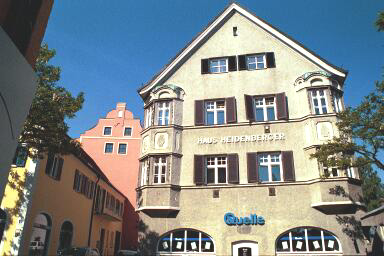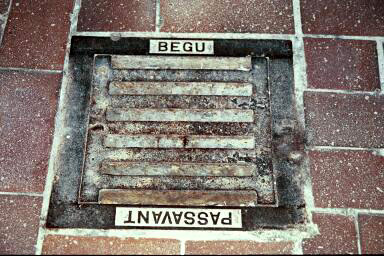The photo above was copied from this website. The heading of the news article is quoted below:
Painting the Nazi gas chambers with defiant realism
Art that deals with the Holocaust isn’t supposed to be abstract, says Mexican-Jewish artist Yishai Jusidman, whose exhibition opens this week in Manhattan.
The painting shown in the first photo above is remarkably similar to one of my photos, which is shown above. I took my photo inside a building at the Memorial Site of the Natzweiler-Struthof concentration camp and put it on this page of my website. To get this photo, I had to go behind the cremation oven; I suspect that few people have taken this particular shot.
Do you notice any difference between my photo and the painting by Yishai Jusidman? Look at the lower right hand corner of my photo: there is a bit of a circular metal object. Above the circular object is what looks like a door frame that is painted blue. Now look at my photo below, which was taken from the opposite side of the room that shows the pipes. Notice the blue door frame on the right side of the oven.
The following text, copied from my website, describes my two photos above:
The photograph [above] shows the single oven in the [Natzweiler-Struthof] crematorium. Until the crematorium was finished in October 1943, the corpses were burned in a mobile crematorium placed near the farm at Struthof, about half a mile from the main camp.
According to a book which I purchased as the [Natzweiler-Struthof] Memorial site, the showers were added in November 1943. Although some tourists believe that this was the gas chamber at Natzweiler, the book says, “The chamber used for the gas experiments was placed outside the camp, near the farm in a building near the hotel: the date when it began working is impossible to tell, but it is known that during the summer of 1943, it was used regularly; it was there that during the summer of 1943 particularly, some Jews, men and women, coming from Auschwitz, were ‘treated’ with gas before they were killed.”
The expression “treated with gas” refers to experiments in which prisoners were subjected to mustard gas and then treated for their burns in an attempt to find the best antidote for the gas. Mustard gas had been used as a weapon by both sides in World War I, so the Nazis wanted to be prepared in case the Allies decided to use it again in World War II. As a young man, serving in the German Army in World War I, Adolf Hitler had been temporarily blinded by a gas attack, so he was not inclined to use gas as a weapon, even though the Nazis had deadly serin gas available as a Weapon of Mass Destruction.
In taking the two photos above, my purpose was not to be artistic. I wanted to show that the cremation oven was located right next to the outside wall of the shower room. I included a bit of the oven, in order to show how close the oven was to the wall. In the photo of the oven, I included the door frame in order to show how close the oven was the the wall of the shower room. I believe that the water for the shower might have been heated by the cremation oven.
Jusidman painted a picture of the outside wall of the Natzweiler-Struthof shower room, but deliberately cut the oven out of the picture so that he could pass this off as the inside of a gas chamber. He deliberately painted in a door to make the viewer think that the inside of a gas chamber is shown, when in actuality, his painting shows the outside wall of a shower room.
The article about the paintings of Jusidman also includes the photo below. Judisman did his paintings from photographs; the painting of the Mauthausen door is remarkably similar to a photo on this page of my website.
Can anyone guess what my purpose was in photographing the Mauthausen gas chamber door in this way? Hint: I was not trying to be artistic. I also took the photo below to make it absolutely clear what I was trying to say.
I followed the water pipes from the morgue room into the gas chamber and then photographed the pipes inside the gas chamber. The Mauthausen Memorial Site does not claim that poison gas came through the shower heads in the gas chamber. The claim is that the Mauthausen gas chamber had a device for inputting the gas that was removed by the Nazis before they abandoned the camp.
Jusidman’s artistic painting of the door into the Mauthausen gas chamber ignores the fact that my photos prove that the Mauthausen gas chamber was a shower room, not a gas chamber. Unless, of course, the shower room was a multi-purpose room where the prisoners could shower or be gassed with Zyklon B.
Jusidman made his painting of the Mauthausen door blue because he wanted to show the blue color left by Zyklon-B, the poison gas that was used by the Nazis. The photo below shows Prussian Blue stains on the walls of the Majdanek gas chamber. (Or is this a room at Majdanek where clothing was disinfected with Zyklon-B to kill the lice that spreads typhus?)
This quote is from the news article:
In contrast to the aesthetic technique of Tuymans, which emphasizes the artificiality of the painting, Jusidman insists on creating near-exact replications of the original pictures, to the point where the viewer questions whether the resulting artwork is a painting, a photograph or perhaps some combination of both. Setting aside the charged subject matter, Jusidman’s technique on its own could evoke controversy: He uses the pigment known as Prussian Blue, a color with complex meanings and implications in the context of the Holocaust. For one, as Jusidman writes on his website: “The Zyklon B product that was used as a killing agent from 1940 through 1945 often produced blue stains on the walls of the gas chambers by way of a chemical reaction with the brick and mortar. Such stains are still very much apparent in the structures at Majdanek. The cyanide-iron compound of these stains is chemically identical to the painter’s pigment known as Prussian Blue.” He studied this chemical compound to arrive at the formula for the blue pigment he used in the painting series. […]
Despite his direct use of historical materials, Jusidman reiterates that this is not an exhibition about the Holocaust. “My paintings do not deal with the Holocaust, but rather with the possibility of its representation,” Jusidman says in an interview with Haaretz Gallery.
Or his paintings could deal with misrepresentation of photographs that were taken to disprove the gassing of prisoners.















































